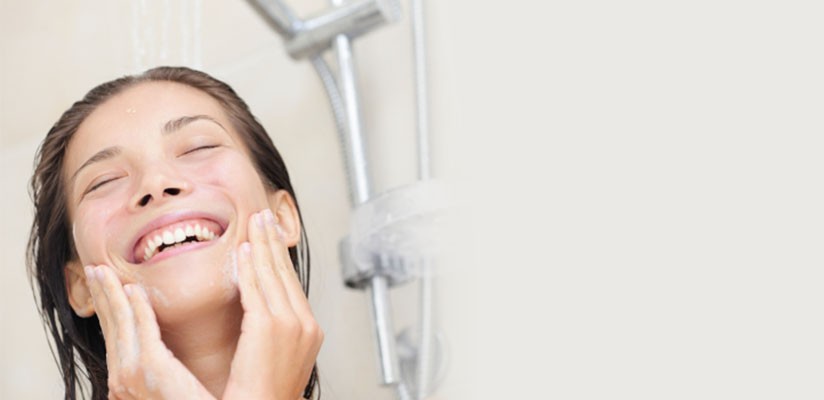The Right Way to Wash Your Face

The best temp for your skin? Use lukewarm water, not hot or cold, to wash your face—in the shower or at the sink.
Cleansing is an integral first step for any home skin-care regimen. Washing your face—morning and night—helps to remove makeup and/or sunscreen, daytime grime that's collected on your face and in your pores, bacteria, dead skin cells, and skin oil. It also preps your skin for any products you're applying afterward, helping them to be better absorbed. (Leaving makeup or sunscreen on at night can inhibit the skin's natural exfoliating process, which sloughs off dulling dead skin cells.)
Here's how to wash properly so it doesn't irritate the skin or strip it of key oils:
> Be sure to always use a gentle cleanser (free from chemicals like parabens and triclosan, an antibacterial; perfumes; and dyes, all of which can irritate sensitive skin). If a cleanser is too harsh, it can strip the skin of natural oils, triggering excess oil production. That's why I created the super gentle, yet super effective Replere Deep Clean & Clarify Face Wash, which is good for all skin types.
You may also need to use a gentle makeup remover before cleansing, particularly around your eyes if you use waterproof makeup. (Not properly removing eye makeup is a sure way to trigger eye irritations.) When cleansing around the eyes, gently dab—don't rub—the remover. Since the skin around the eyes is the thinnest anywhere on the body, it's easy to rub and tug and damage this delicate skin, triggering fine lines and deeper wrinkles (called "crow's feet" around the eyes).
> Wash hands before washing your face. In one study, researchers found that hands contain up to 150 different kinds of bacteria.
> Use lukewarm, not hot or cold, water. Extreme temperatures can strip essential oils in the skin and trigger broken capillaries (tiny blood vessels on the surface of the skin). Water that's too hot or too cold can also irritate sensitive and rosacea-prone skin.
> Gently dab—never rub—skin with towel to dry. Harsh rubbing with a towel (or washcloth during the cleansing process) can irritate skin and, over time, the trauma can contribute to fine lines and wrinkles.
> Try a toner. A toner can give the skin a second round of cleansing, helping to remove any dirt, makeup, or oil left behind. I'm a big advocate of using alcohol-free toners, like Replere Pore Minimize & Mattify Skin Tonic. Alcohol can strip the skin of natural oils, leaving the complexion tight, dry, and in desperate need of moisture. It can also trigger the production of oil production, which—in the case of oily skin, in particular—is not always a good thing.
Keep in mind that a toner is not essential to a skin-care regimen, but I've found that many of my patients like the "clean" feeling a toner can give the skin (some like to use it throughout the day to help reduce shine and freshen the skin). Many toners can help restore the natural pH levels of skin.
Look for toners that feed the skin with gentle natural ingredients like witch hazel, green tea, rosemary, grapeseed, rosewater, and/or chamomile. Toners can also contain exfoliating ingredients like glycolic, salicylic, and/or azelaic acid, which can help slough off dead skin cells, keeping pores clear and the complexion radiant.
Happy cleansing!
RESOURCES:
i "Women Have More Diverse Hand Bacteria Than Men, According to CU-Boulder Study," CU News Center, University of Colorado Boulder, November 3, 2008;http://www.colorado.edu/news/releases/2008/11/03/women-have-more-diverse-hand-bacteria-men-according-cu-boulder-study


